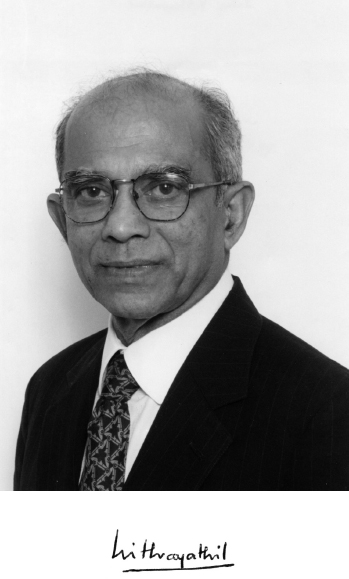1937–2011
Elected in 2000
“For the invention of thyristor-controlled series capacitor system and advancement of high voltage direct current (HVDC) transmission technology.”
BY ARUN PHADKE
JOHN JOSEPH VITHAYATHIL passed away peacefully on May 24, 2011, at his Portland home surrounded by his wife and children after a long and courageous battle with lung cancer. John was born in Trivandrum, Kerala, India, on February 17, 1937, to Joseph and Theresiamma Vithayathil. Throughout his life, John’s wisdom and intellect were exceeded only by his caring and kindness for his family and friends and his unmatched love for his wife Rani.
John received his BSc degree in electrical engineering from Trivandrum Engineering College and his PhD from the Indian Institute of Science in 1967. Impressed by his doctoral dissertation related to high-voltage/direct current power transmission, the Bonneville Power Administration (BPA) offered him an engineering position in Portland, Oregon. John brought his family to Portland in 1967 and for nearly 45 years he and Rani called the Portland/Vancouver area home where they raised their four children.
After 20 years, John retired from the government and worked as an independent consultant for nearly 25 years. Internationally recognized as an expert of high-voltage direct current transmission, he also made key contributions to high-voltage alternating current transmission, including the invention of the Rapid Adjustment of Network Impedance (RANI)
scheme, which he named after his beloved wife. John was awarded several patents throughout his professional career and received numerous distinctions and awards, including being named an IEEE fellow. His highest professional honor came in 2000 when he was inducted into the National Academy of Engineering.
John was a mentor and friend to many engineers—including myself—who remember fondly his dedication to the profession and his desire to promote good research whenever he came across it. My own connection to John came about because of his enthusiastic support of the emerging field of synchronized phasor measurements in power systems, and his unstinting backing of this activity at Virginia Tech. I well remember how he met and overcame opposition from some well-known engineers in his company and staunchly defended this emerging technology as being worthy of BPA’s backing. This technology has now become a key ingredient of the modern power system monitoring and control activities throughout the world.
One of the clearest evidences of the high regard in which he was held by his peers was the technical collaboration between him and the renowned power engineering expert Edward Kimbark. Later Dr. Kimbark asked John to collaborate with him on writing many technical papers and textbooks on the subject of high-voltage direct current transmission.
John was a valued instructor for many courses offered by the University of Wisconsin–Madison. In this activity he collaborated with Willis Long of Wisconsin, who shares these memories: “The year was probably 1975. I had met John earlier at BPA when with his assistance I was building an EMTP model of the Pacific HVDC Intertie. He contacted me at the University of Wisconsin where I was then on the faculty. A group of engineers from Zaire were planning to visit BPA for a few weeks of training. An HVDC transmission system was to be built in Zaire to supply electrical energy for their copper mining operation. I said certainly and a team of 10 young engineers arrived with John on a Monday morning. He and I shared the lecturing, and UW Professor Dan Reitan aided us by setting up exercises on the university’s HVDC physical
simulator. The students greatly enjoyed the week and were a pleasure to be around. Probably 20+ years later I was at the Apollo HVDC station near Johannesburg, South Africa. An engineer came up to me and informed me that he had been in that class. I did not recognize his name until he told me that he had resumed using his Christian name after moving from Zaire to postapartheid South Africa. A second memory of John relates to a joint research contract on HVDC projects. John contacted me about supporting a research project on active filters for HVDC converter stations. I had a graduate student just at the point of needing a good project and he was happy to take it on. The student was most impressed by having an expert of John’s stature be part of his research project.”
In his younger days, John was an avid field hockey and soccer player, serving as captain for his college soccer team. As time went by, he enjoyed taking his wife on trips around the world and playing bridge with friends. But for John nothing matched the joy of being a grandfather, or Appapen, to his grandchildren. Annual family trips to the beach or central Oregon were the highlight of the year for the entire family.
John is survived by his loving wife of 46 years, Rani; daughter Mariamma, her husband Jacob, and their children Paul and John; son Jose; daughter Rose, her husband Steve, and their children Megan and Christopher; daughter Theresa, her husband Brett, and their children Catherine and Joseph; sisters Mary and Sister Maria Theresia; and brothers Paul, Antony, and Francis. He was preceded in death by his parents and his brothers Joseph and Cardinal Varkey Vithayathil.





